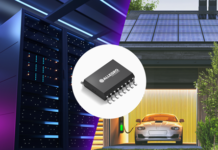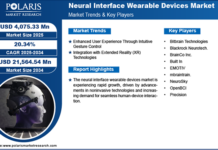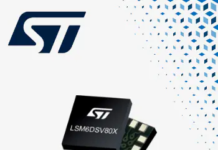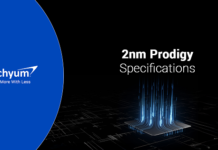
Context-aware edge AI sensors:
Imagine a drummer, lost in the groove, her mind focused solely on her music. She pauses, looks at her smartphone; not for the time, but to get instant feedback on her performance: tempo, precision, and even technique. The smart drumsticks in her hands have been collecting real-time data, measuring her beat, force, and rhythm with accuracy. The smartphone connected to these drumsticks offers immediate guidance on how to improve and pinpointing areas for refinement.
This is quickly becoming a reality. Today’s technology is rapidly moving from simple tracking of heart beats and steps to a new generation of smart devices able to contextualize user movements. These devices can provide deep insights that go beyond the surface level. Wearables and smart devices are becoming smarter, with edge AI sensors enabling context-aware intelligence.
Evolving consumer expectations: from passive tracking to active insight
Wearables used to be simple tools that measured heart rate, calories, or steps. However, as successful as they have been, these devices now face the challenge of evolving consumer expectations. Users no longer want just data; they want insights and actionable feedback that keeps them engaged. With more advanced technology, wearables are expected to deliver personalized experiences, anticipating needs and responding to actions.
Consider the shift underway. Fitness trackers and the like collect vast amounts of data, but the next step is contextual awareness. Users want more than raw numbers. They seek real-time decisions and predictive feedback. Wearables and smart devices need to move beyond passive tracking and truly understand their environment. They need to be able to enrich everyday life by providing meaningful insights and creating an experience that actively engages users, rather than just measuring their movements.
Empowering smart devices to understand and respond to context
This shift is fundamentally about moving sensors from being just reactive, to proactively responding to external and environmental context. Wearables and smart devices of tomorrow will not just record your heart rate. They will know if you are standing still, walking, or in the middle of a high-impact sport or drop. The next generation of smart devices will be able to analyze environmental data alongside personal biometrics to make smarter, more informed decisions.
Think of it as going from being reactive to anticipating the unexpected – like the smart drumsticks example, which continuously measure technique and performance. At the same time your smartphone can provide feedback on not just tempo but also rhythm precision, recovery time, and technique. In sports, wearables are moving beyond tracking heart rates to understanding the dynamics of a runner’s stride, or the power behind a throw. These insights are delivered in real-time and are tailored to the individual, not just generic benchmarks.
What this means for consumer electronics
As smart devices evolve from passive trackers to context-aware personalized assistants, this opens up new possibilities for the consumer electronics industry to truly innovate.
Whether it’s an angler using a smart fishing rod analyzing his cast or a skier tracking edge control through turns, smart devices and wearables can offer insight into adjusting strength, technique, gait or throwing angles across a number of activities. Real-time contextual analysis enables the next generation of smart devices to combine technology with passion, helping people take their sports and hobbies to the next level. These devices don’t just measure performance; they create a more engaging and personalized experience, allowing users to improve faster and smarter.
For athletes and fitness enthusiasts recovering from an injury, such as knee surgery, next generation smart devices can track strain and offer highly customized feedback. If the device detects excessive force or improper movement, it can warn the user to adjust their activity, preventing overexertion and safeguarding against further injury or hindering the healing process. This level of tailored monitoring ensures that users can safely improve their performance, pushing their limits without risking long-term damage.
Take a jogger running around a lake early in the morning before going to work. She experiences a health issue or stumbles in an unfortunate way. Her smart device detects the unusual pattern, the sudden downward velocity and following that the lack of body movement, then triggers an emergency alert, sending for help or notifying emergency services. This is enabled by an edge AI sensor monitoring both the user’s body and the environment, combining real-time tracking with AI to contextualize a serious incident and take action. The smart device no longer only passively tracks and records data; it proactively analyses what happens and takes action, calling for help and providing peace of mind.
The technology enabling this shift
The underlying technologies that make these advancements possible are edge AI inertial sensors providing real-time data processing on the device itself. Rather than relying on cloud services to do that remotely, edge processing of the motion data at the device level is crucial for fast, responsive decision-making. With machine learning running locally on the device, these sensors can continuously assess the situation, learn from the data they collect, and make adjustments in real-time.
IMU (Inertial Measurement Unit) sensors can capture high-intensity events that would typically saturate traditional accelerometers resulting in monitoring stalls and glitches. This advanced sensor technology ensures that important data is not lost during high-impact activities without compromising energy efficiency.
When smart devices become personal assistants
The future of consumer electronics is one where smart devices are more than just accessories, they will be indispensable personal assistants that blend seamlessly into our daily lives. The vision is clear: wearables and smart devices will not just collect and display data; they will capture, analyze, and learn, improving over time to offer more precise insights and recommendations to the user.
We will see the integration of multi-sensing in increasingly compact form factors. Devices like smart rings, smartwatches, and even smart clothing will combine multiple sensing types in a single smart device, offering consumers a fully integrated, real-time health and performance monitoring system.
Seizing the opportunity in consumer electronics
For consumer electronics companies, the path forward is clear: incorporating context-aware edge AI sensors into new products presents a significant opportunity. This technology is poised to unlock new market potential, enabling the creation of innovative product categories and new brands for the years ahead.
Responding to evolving consumer needs, companies can secure a competitive advantage in an increasingly crowded market. This will allow them to create products that go beyond basic functionality, offering solutions that actively address emerging consumer expectations.
As the era of context-aware smart devices takes shape, there’s a real opportunity for companies to build the next generation of consumer electronics.
For more information, visit www.st.com.
















